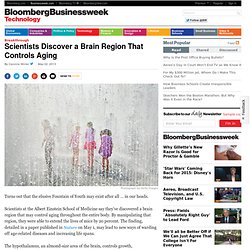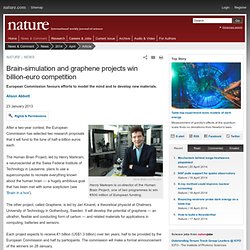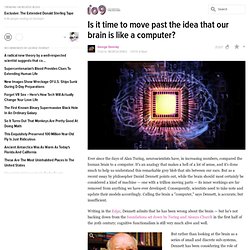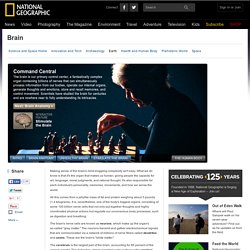

Scientists create detailed 3-D model of human brain. Loading...

April 22, 2014 Sign in Sign Out Create an Account Subscribe Text Size Normal Large Extra large Latest News L.A. Coachella Music Festival In Case You Missed It Sports Basketball College Sports Photos California Cookbook. Scientists Discover a Brain Region That Controls Aging. Turns out that the elusive Fountain of Youth may exist after all … in our heads.

Scientists at the Albert Einstein School of Medicine say they’ve discovered a brain region that may control aging throughout the entire body. By manipulating that region, they were able to extend the lives of mice by 20 percent. The finding, detailed in a paper published in Nature on May 1, may lead to new ways of warding off age-related diseases and increasing life spans. The hypothalamus, an almond-size area of the brain, controls growth, reproduction, and metabolism but also initiates aging, according to the study. Dongsheng Cai, a physiologist at Albert Einstein College of Medicine in New York, together with colleagues, realized this by tracking NF-κB, a molecule that controls DNA transcription and is involved in inflammation and the bodily response to stress.
What’s more, the inhibitor seems to block the lamentable physical decline that occurs with age. Reversing memory loss. Aplysia californica (credit: Nordelch/Wikimedia Commons) Neuroscientists at The University of Texas Health Science Center at Houston (UTHealth) have reversed memory loss in sea-snail nerve cells by by retraining them on optimized training schedules.

This may be a major step in helping people with memory loss tied to brain disorders such as Alzheimer’s disease, the researchers suggest. “Although much works remains to be done, we have demonstrated the feasibility of our new strategy to help overcome memory deficits,” said as well as This latest study builds on a 2012 investigation by John “Jack” Byrne, Ph.D., the study’s senior author, that pioneered this memory enhancement strategy. He is also director of the W.M. The 2012 study showed a significant increase in long-term memory in healthy sea snails called Aplysia californica, an animal that has a simple nervous system, but with cells having properties similar to other more advanced species including humans.
Anatomy of the Brain. The anatomy of the brain is complex due its intricate structure and function. This amazing organ acts as a control center by receiving, interpreting, and directing sensory information throughout the body. The brain and spinal cord are the two main structures of the central nervous system. Le cerveau à tous les niveaux. HBP_executive_summary.pdf. Re-creating the brain with a $1.6-billion supercomputer project. There are seven billion human brains on the planet, but even the best minds in neuroscience aren’t really sure how they work.

How does a network of a hundred trillion neural connections generate thoughts and feelings and motivate action? An international team of researchers is taking a crack at finding out by building a brain of its own. Brain-simulation and graphene projects win billion-euro competition. Denis Balibouse/Reuters Henry Markram is co-director of the Human Brain Project, one of two programmes to win €500 million of European funding.

€2 billion in European funding goes to Graphene and Human Brain projects. Awards €2 billion in European funding goes to Graphene and Human Brain projects Research aims to revolutionize computing and better understand the human brain Large-scale interdisciplinary projects titled Graphene and the Human Brain Project will receive up to €1 billion each ($1.4 billion or £8.5 million) over 10 years as the winners of the European Commission’s Future and Emerging Technologies (FET) Flagships Initiative.
The winners were announced today by Neelie Kroes , Vice-President of the European Commission and High Commissioner for the Digital Agenda for Europe, at a press conference in Brussels. They were selected by a panel of leading scientists, professors, Nobel Prize winners and industrialists. Interactive: Map of the human brain. Is it time to move past the idea that our brain is like a computer? Is it time to move past the idea that analogies are perfect?

No, it's not. Because nobody except insufferable pedants treat analogies like they're somehow either perfect or irredeemably broken. The brain is like a computer in many ways. It's not exactly like a computer, but it is like one. It processes inputs and produces outputs in a way that nothing we have now except a computer system even comes close to. There are ways that computers and brains are different. Brain, Brain Information. Making sense of the brain's mind-boggling complexity isn't easy.

What we do know is that it's the organ that makes us human, giving people the capacity for art, language, moral judgments, and rational thought. It's also responsible for each individual's personality, memories, movements, and how we sense the world. All this comes from a jellylike mass of fat and protein weighing about 3 pounds (1.4 kilograms). It is, nevertheless, one of the body's biggest organs, consisting of some 100 billion nerve cells that not only put together thoughts and highly coordinated physical actions but regulate our unconscious body processes, such as digestion and breathing. Research Perspectives - BRAINSTORM: Unravelling the inner workings - 2012-fall.pdf.